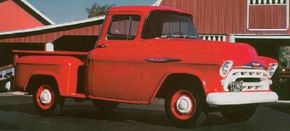1957 Chevrolet Cameo Carrier
The 1957 Chevrolet Cameo Carrier's accent trim now included a horizontal band on each side of the pickup box, with a chrome bow-tie emblem at the leading edge and the word "Cameo" inside the painted strip.
The Cameo Carrier turned out to be something of a lame-duck vehicle in 1957, because only 2,572 were sold that year. This was partly due to the Cameo's competitors catching up. Ford introduced the Ranchero, a car-based pickup with all the amenities of a coupe; Dodge launched the D-100 Sweptside with a finned pickup box and flashy two-tone paint treatments; and International marked its 50th anniversary with a new smooth-sided A100 Custom pickup.
Advertisement
The 1957 Chevrolet truck line came with twin windsplits on the hood (like the passenger car) plus a more intricate double-trapezoid grille on light-duty models. Chuck Jordan didn't care for the overall effect. "The 1957 pickups, in my opinion, came out poorly," he comments. "I was out of the Chevy truck studio by the time the 1957s were done. They were jazzy, chromed-up, contrived in the grille opening-fussy. The 1957 pickup sort of lost its purity. I didn't like it."
Buyers could shop among 15 solid body colors, five two-toning colors, and four interior color combinations. The Cameo's pickup bed had bright moldings above and below the accent color and bright hubcaps with fluted trim rings. In the 3200 and 3600 series, the pickup bed length was extended to 98 inches, an increase of eight inches. Panels and Suburbans adopted twin vertical taillights in place of the single lamp seen on 1955-1956 versions.
All 1957 trucks now came with a dished steering wheel plus safety door locks and strikers. The new lock had a rotor housing with an extended outer flange. This flange slid behind an overhanging plate on the striker. When the door was shut and the rotor and striker engaged, they couldn't come apart in a forward or rearward direction. So in a collision, even if the door gap was stretched or distorted, the door wouldn't fly open. Yet the new striker allowed the same ease of opening and closing as before.
For more on the 1957 Chevrolet light-duty trucks, continue to the next page.
For more information on cars, see:
- Classic Cars
- Muscle Cars
- Sports Cars
- Consumer Guide New Car Search
- Consumer Guide Used Car Search
